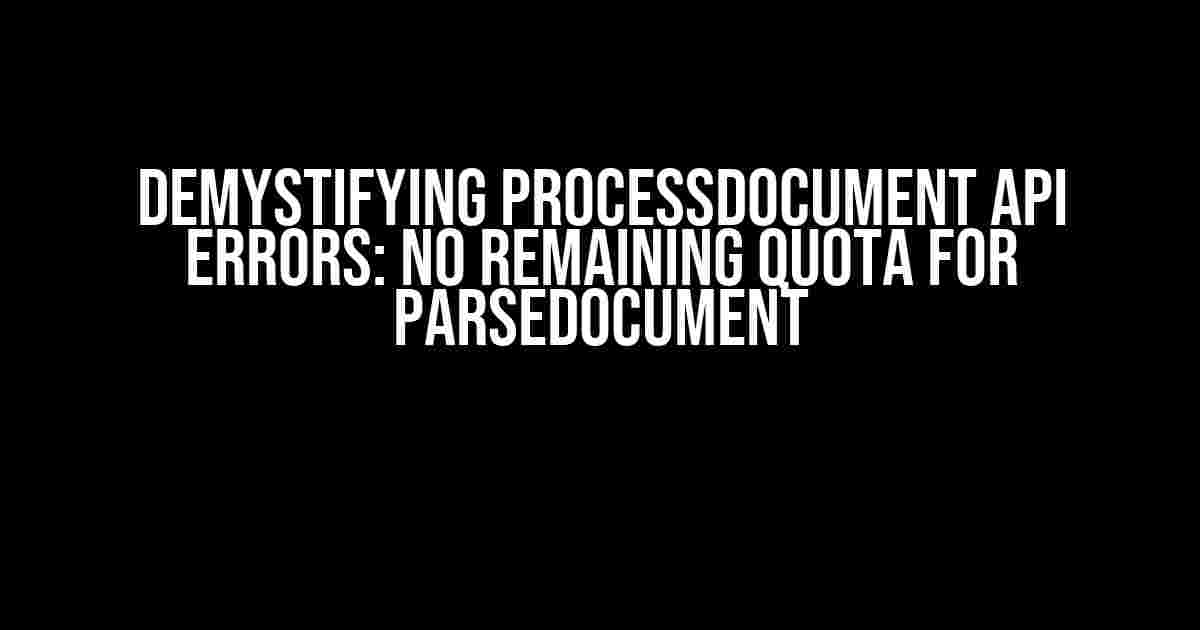If you’re reading this, chances are you’re frustrated, stuck, or possibly even about to pull your hair out due to the infamous “No remaining quota for ParseDocument” error plaguing your ProcessDocument API experience. Fear not, dear developer, for you’re in the right place! In this comprehensive guide, we’ll delve into the depths of this error, explore its causes, and provide you with actionable solutions to get your API up and running seamlessly.
What is the ProcessDocument API?
In case you’re new to the world of document processing, the ProcessDocument API is a powerful tool designed to extract data from various document types, such as PDFs, images, and Word files. It’s an indispensable asset for businesses and developers seeking to automate data extraction, reduce manual labor, and increase efficiency.
The “No Remaining Quota for ParseDocument” Error: What’s Behind It?
Before we dive into the solutions, it’s essential to understand the underlying causes of this error. The “No remaining quota for ParseDocument” message typically appears when your API request exceeds the allocated quota for document parsing. This quota is usually measured in terms of the number of pages or documents processed within a specific time frame.
Here are some common scenarios that might lead to this error:
- Excessive API Calls**: If your application makes an unusually high number of requests within a short span, you may hit the quota limit, resulting in the error.
- Large Document Sizes**: Processing large documents can rapidly consume your quota, especially if they contain many pages or high-resolution images.
- Inefficient API Usage**: Poorly optimized API calls or inefficient document processing can lead to quota exhaustion.
- Third-Party Library or SDK Issues**: Bugs or limitations in the libraries or SDKs used to interface with the ProcessDocument API can cause quota-related errors.
Resolving the “No Remaining Quota for ParseDocument” Error
Now that we’ve identified the potential causes, let’s explore the solutions to get your API up and running again:
1. Monitor and Optimize API Calls
Implement API call tracking to identify patterns and areas for optimization. This can be achieved using:
- API Analytics Tools**: Leverage tools like Google Analytics, API Gateway, or third-party services to monitor API request volume and frequency.
- Logging and Auditing**: Enable logging and auditing mechanisms to keep track of API requests, response codes, and error messages.
By analyzing your API call patterns, you can:
- Identify and refactor inefficient API calls
- Batch requests to reduce the overall number of calls
- Implement caching mechanisms to minimize redundant requests
2. Optimize Document Sizes and Complexity
Reduce the size and complexity of documents being processed by:
- Compressing Files**: Use compression algorithms to reduce file sizes, making them more efficient to process.
- Splitting Large Documents**: Divide large documents into smaller, more manageable chunks to reduce processing time and quota consumption.
- Removing Unnecessary Pages**: Strip unnecessary pages or sections from documents to minimize processing requirements.
3. Improve API Usage Efficiency
Refactor your API usage to minimize quota consumption by:
- Batching Similar Requests**: Group similar requests together to reduce the overall number of API calls.
- Using Async Processing**: Leverage asynchronous processing to offload document processing, reducing the load on your API and quota consumption.
- Implementing Queue-Based Processing**: Use queue-based processing to handle document requests in a more efficient and scalable manner.
4. Update Third-Party Libraries and SDKs
Ensure you’re using the latest versions of libraries and SDKs to interface with the ProcessDocument API. Outdated versions can lead to quota-related errors due to inefficiencies or bugs.
// Example: Update Node.js SDK
npm install process-document-sdk@latest
5. Contact ProcessDocument API Support
If none of the above solutions resolve the issue, it’s time to reach out to the ProcessDocument API support team. They can assist you in:
- Verifying account quota limits and usage
- Identifying potential API usage inefficiencies
- Providing guidance on optimizing API calls and document processing
- Granting temporary quota increases or exploring custom quota solutions
| Solution | Description | Implementation Difficulty |
|---|---|---|
| Monitor and Optimize API Calls | Track and optimize API requests to reduce quota consumption | Easy-Moderate |
| Optimize Document Sizes and Complexity | Reduce document size and complexity to minimize processing time | Moderate |
| Improve API Usage Efficiency | Refactor API usage to minimize quota consumption | Easy-Moderate |
| Update Third-Party Libraries and SDKs | Ensure you’re using the latest versions of libraries and SDKs | Easy |
| Contact ProcessDocument API Support | Reach out to the ProcessDocument API support team for assistance | Easy |
Conclusion
The “No remaining quota for ParseDocument” error can be a frustrating obstacle, but by understanding the causes and implementing the solutions outlined in this guide, you’ll be well on your way to resolving the issue and optimizing your ProcessDocument API experience.
Remember, it’s essential to monitor and optimize your API calls, document sizes, and complexity, as well as improve API usage efficiency. By doing so, you’ll minimize quota consumption, reduce errors, and ensure seamless document processing.
Don’t let the “No remaining quota for ParseDocument” error hold you back. Take control of your API experience, and start processing documents like a pro!
Frequently Asked Questions
Get the scoop on the most common ProcessDocument API Errors and how to overcome them!
What does the “No remaining quota for ParseDocument” error mean?
This error means you’ve reached the maximum number of documents that can be parsed within a certain time frame. Think of it like filling up a bucket – once it’s full, you need to wait for it to refill before you can parse more documents!
How can I avoid hitting the quota limit for ParseDocument?
To avoid this error, try parsing documents in batches, using a queueing system, or optimizing your document parsing process. You can also consider upgrading your plan to increase the quota limit. Remember, it’s all about pacing yourself!
What’s the best way to handle the “No remaining quota for ParseDocument” error in my code?
When you get this error, catch the exception, and add a delay before retrying the request. You can also use an exponential backoff strategy to avoid overwhelming the API. Just remember to handle the error gracefully and provide feedback to your users!
Can I get more quota for ParseDocument by contacting the support team?
While the support team can’t increase the quota instantly, they can help you with a temporary quota increase or provide guidance on optimizing your document parsing process. Just reach out to them, and they’ll do their best to assist you!
Are there any workarounds for the “No remaining quota for ParseDocument” error?
If you’re hitting the quota limit frequently, consider using alternative APIs or services that can help you parse documents. However, be sure to review their pricing and quota limits before making the switch. Sometimes, a change of pace is all you need!


